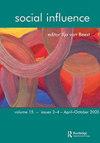我们什么时候看到别人曲解了他们的感受?用直接和间接的方法从情绪表情中发现欺骗
IF 0.6
3区 心理学
Q3 PSYCHOLOGY, SOCIAL
引用次数: 6
摘要
非语言表达的情绪并不总是与人们的真实情绪联系在一起。我们调查了观察者区分真实和谎言的能力是否因积极和消极的情绪表达而不同。参与者对目标进行判断,要么模拟或真正体验积极或消极的情绪。通过被测者对被测者情绪的推断和对被测者欺骗行为的直接判断来检测被测者的欺骗能力。直接测试的结果显示,参与者无法准确区分真话者和说谎者,无论他们表达的是哪种情绪。正如预期的那样,间接情绪测试也产生了影响:当参与者从消极情绪表达中推断出经历过的情绪时,他们区分出了说谎者和诚实者,而不是积极情绪表达。本文章由计算机程序翻译,如有差异,请以英文原文为准。
When do we see that others misrepresent how they feel? detecting deception from emotional faces with direct and indirect measures
Abstract Nonverbally-expressed emotions are not always linked to people’s true emotions. We investigated whether observers’ ability to distinguish trues from lies differs for positive and negative emotional expressions. Participants judged targets either simulating or truly experiencing positive or negative emotions. Deception detection was measured by participants’ inference of the targets’ emotions and their direct judgments of deception. Results of the direct measure showed that participants could not accurately distinguish between truth tellers and liars, regardless which emotion was expressed. As anticipated, the effects emerged on the indirect emotion measure: participants distinguished liars from truth tellers when inferring experienced emotions from negative emotional expressions, but not positive emotional expressions.
求助全文
通过发布文献求助,成功后即可免费获取论文全文。
去求助
来源期刊

Social Influence
PSYCHOLOGY, SOCIAL-
CiteScore
1.50
自引率
0.00%
发文量
4
期刊介绍:
Social Influence is a journal that provides an integrated focus for research into this important, dynamic, and multi-disciplinary field. Topics covered include: conformity, norms, social influence tactics such as norm of reciprocity, authority, scarcity, interpersonal influence, persuasion, power, advertising, mass media effects, political persuasion, propaganda, comparative influence, compliance, minority influence, influence in groups, cultic influence, social movements, social contagions, rumors, resistance to influence, influence across cultures, and the history of influence research.
 求助内容:
求助内容: 应助结果提醒方式:
应助结果提醒方式:


